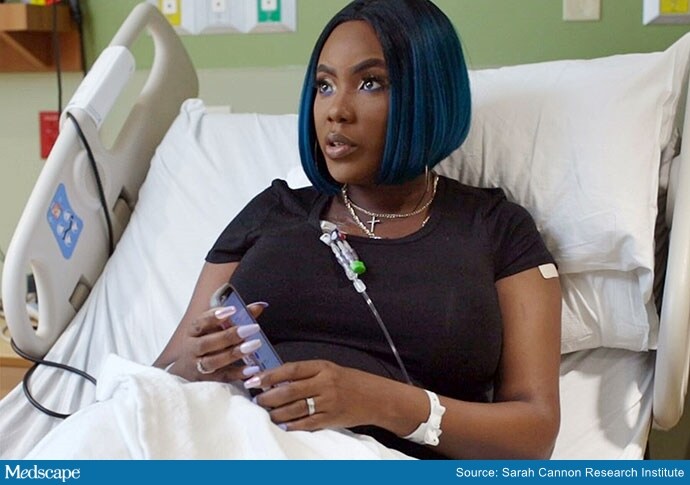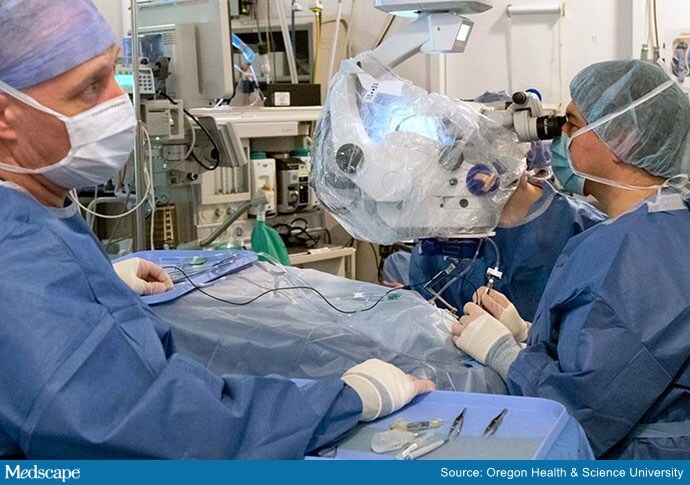Home » Health News »
CRISPR and the End of Genetic Diseases
In July 2019, Victoria Gray woke up in a sunlit, pale green hospital room at Sarah Cannon Research Institute in Nashville. A frozen bag of her genetically edited blood cells thawed by her bed. Gray, a 34-year-old mother of four from Forest, MS, was about to become a medical trailblazer.
When Gray was 3 months old, her grandmother hoisted the writhing, squalling infant from the bathtub and rushed her to the emergency room. There, doctors diagnosed Gray with sickle cell disease (SCD), a blood disorder that damages major organs and causes lifelong bouts of excruciating pain.
SCD results from a mutation in the HBB gene. The glitch garbles instructions so that instead of making a protein component called beta-globin to ferry oxygen, the body produces an abnormal version called hemoglobin S.
The result: Red blood cells turn sticky and crescent shaped. The sharp spikes jam and shred the lining of the blood vessels and can cause heart attacks and strokes, even in kids. Doctors warned Gray’s mother that her daughter may not live past her 6th birthday.
Gray inherited her disease from her parents. It’s passed down through recessive sickle cell genes from the mother and the father. Any child born to two people who carry the malfunctioning gene but who don’t have SCD has a 25% chance of having the condition. If both parents have SCD, all of their children will, too. The disease strikes mainly people who trace their ancestry to Africa, where the sickle cell gene is thought to have protected against severe malaria.
Now, Gray sat up in her bed in Nashville, her hair in a sleek bob and her nails manicured in pink. She was poised to disrupt that DNA destiny for good.
Editing With Genetic Scissors
Weeks earlier, Gray’s doctor, Haydar Frangoul, MD, medical director of pediatric hematology at Sarah Cannon Research Institute, had extracted billions of Gray’s stem cells and sent them to an undisclosed lab in Europe. There, scientists applied electric pulses to temporarily pry open pores in the membranes of her cells. They then inserted “molecular scissors” through the entry in an attempt to unkink her scrambled genetic code. The re-engineered cells were frozen and shipped back to Nashville.
The blood cells now thawed, Frangoul lifted a syringe to a central line leading to Gray’s chest and pushed the plunger. Gray’s pulse quickened and her eyes welled as the infused cells coursed through her veins, kickstarting the production of a healthier form of hemoglobin. It also promised to deliver Gray from a lifetime of fits of pain and heart trouble that, by her early 30s, landed her in the hospital about every other month.

Victoria Gray on the day of her infusion with her own stem cells that had been genetically edited to alleviate symptoms of her sickle cell disease.
The splicing technique used to override the genomic codes responsible for Gray’s illness is CRISPR-Cas9. It’s a simpler, cheaper, and more precise version of the genetic editing technologies that surfaced in the 1990s but never lived up to the hype.
CRISPR enables scientists to delete or rewrite mutations in DNA. It could pave the way to eradicating a host of hereditary conditions, ranging from cystic fibrosis and Down syndrome to blindness and dyslexia.
In theory, CRISPR also could be used — even in an embryo — on specific regions of a chromosome to customize a person’s physical, mental, and molecular traits. It might, for instance, ultimately allow selecting the color of an unborn child’s hair or eyes. And CRISPR may make it possible to manipulate intelligence levels or the risk of autism, both of which result from a complex interplay of genetics and environment. (Read about gene editing’s ethical stakes.)
But for Gray, CRISPR simply offered hope. Her search for a bone marrow transplant — a risky and, until now, the only cure for SDC — had been fruitless. Then Frangoul approached her with a proposition: become one of the first humans in the world to try this experimental therapy.
“I said, ‘We don’t know for sure if it will work,’ ” Frangoul says. “She said, ‘Sign me up.’ ”
How CRISPR Works
About a decade ago, Jennifer A. Doudna, PhD, was studying bacteria in petri dishes when she deciphered how they fought off viruses. Specifically, the biochemist found that these and other microorganisms defend against infections by memorizing the DNA sequences of previous invaders so that when they return, the immune system is precisely primed to vanquish them.
CRISPR, which stands for clustered regularly interspaced short palindromic repeats, is part of that bacterial immune system. “Palindromic” means any sequence that reads the same forward and backward.
To craft that genetic snapshot, the bacteria steal fragments of the intruder’s genetic code called spacers. They then stitch them into their own DNA, spacers, and repeats, and start making copies, or single-chain molecules known as RNA. Those short chains of CRISPR RNA act as a guide to home in on the matching viral sequence when it’s spotted. Another piece of the CRISPR machinery, an enzyme called Cas9, then cuts the virus and destroys it so it can’t replicate.
In 2012, Doudna, a professor at the University of California, Berkeley, published a groundbreaking paper describing this maneuver. That unleashed CRISPR into a wide medical lexicon. Scientists had an inkling of CRISPR as far back as 1987, when Japanese researchers discovered an “unusual repetitive DNA sequence” in E. coli bacteria. But it was Doudna who cracked the code on how to turn CRISPR into a biohacking tool that, like a cursor on a screen, could correct “typos” in a genome as easily as with words in a sentence.
“It allows you to alter the blueprint of life for any organism you want,” says Eric Olson, PhD, a molecular biologist at the University of Texas who is developing CRISPR-based treatments for muscular dystrophy. “You can’t really overstate the potential long-term impact of this technology on life as we know it.”
In 2020, Doudna and Emmanuelle Charpentier, PhD, now the director of the Max Planck Unit for the Science of Pathogens in Berlin, jointly won the Nobel Prize for Chemistry for their transformative work on “rewriting the code of life.”
CRISPR’s Perilous Line
To date, biologists have employed CRISPR to create fatter goats with longer hair to yield more meat and wool; protect bacteria used to make cheese and yogurt from viral infections; knock out the caffeine gene in coffee plants; and breed “micro pigs” for pets that weigh about 30 pounds, not much bigger than a medium-sized dog like an Irish terrier.
In November 2018, a Chinese scientist named He Jiankui uploaded a YouTube video and announced the births of the world’s first CRISPR-edited humans. He claimed he had tweaked the embryos of twin girls to be resistant to HIV, a disease that in China still carries a deep stigma. The embryos were reimplanted in the mother’s womb.
The blowback was swift. Scientists called for a worldwide halt on using CRISPR directly on embryos, eggs, or sperm to create genetically modified babies. To date, while many countries prohibit the practice, no such international moratorium exists. A Chinese court sentenced He to 3 years in prison.
But it wasn’t long before another scientist, this time in Russia, began telling reporters he wanted to use a similar embryo-editing plan to enable couples who carry a gene for congenital deafness to bear children with normal hearing.

Andreas Lauer, MD, right, edits mutations in the CEP290 gene to restore vision in a patient with rare hereditary blindness. The procedure in March 2020 was the first use of CRISPR directly into a human body.
The dilemma facing the scientific community in light of CRISPR’s vast potential is one of ethics. Where should the line be drawn between eliminating human suffering and manipulating — irrevocably and with unknown consequences — the genetic makeup of future generations?
The technique He used with the Chinese twins is called germline editing. It is performed on embryos and the resulting DNA modifications become permanent and heritable.
Alternatively, in 2020, doctors in Oregon dripped liquid embedded with the CRISPR tool into the retina of an adult who was born with a rare type of hereditary blindness. The drops were designed to repair a gene called CEP290 to restore eyesight. Children and adults with blindness around the world are awaiting preliminary results, due out later this year.
That was the first time that doctors used CRISPR inside a living human body, or “in vivo” gene editing. The patient still carries the blindness gene, so it’s possible that their future children would be born without sight.
Arguably, CRISPR is a means to a rational goal: to fix, cure, or reverse genetic mutations that cause illnesses or otherwise shortchange lives. Older gene therapies mostly treated diseases. But CRISPR offers a far more fraught promise: the ability to banish hereditary diseases from the gene pool.
That future may come with unintended consequences, or “off-target effects.”
“One ethical question to ask in research is, who bears the risks and benefits of a new technology?” says Insoo Hyun, PhD, director of research ethics at the Center for Bioethics at Harvard Medical School. “In the case of germline editing, the benefit may be for the couple, but the risks befall the unborn, and possibly their descendants.”
“Philosophically, do we really want to go down that road?”
In a sense, we already are.
Scientists have shown with mice that CRISPR can curb the symptoms of fragile X syndrome, a genetic cause of autism that can lead to severe sensitivity to light and sound and obsessive and repetitive behaviors. CRISPR also has cured dogs of Duchenne muscular dystrophy, a rare muscle-wasting disease that in people mostly affects boys.
Similar treatments for humans are not far off. And few people may anticipate that future more eagerly than the parents of children with devastating congenital conditions.
Hopes for a Future Cure
Hawken Miller was a strapping baby who weighed 11 pounds out of the gate. When he was 4, his mother, Debra, saw him crying during soccer practice. Hawken looked winded and uncoordinated. Miller took her son to their skeptical pediatrician, convinced that something was seriously wrong.
It took a year for doctors to diagnose Hawken with Duchenne muscular dystrophy. This degenerative disease stems from a mutation in the largest gene in the human body, the dystrophin gene. Boys with Duchenne are born healthy. But because they lack a critical protein that acts as a shock absorber for the muscles, the children’s muscle fibers start breaking down by about preschool.
The disease is inexorable. By middle school, many kids can no longer walk. By young adulthood, they often need a ventilator to breathe. Now 24, Hawken is a health journalist who lives independently in Los Angeles. He gets around in a wheelchair, sleeps with a breathing machine, and takes two medications every day for his weakening heart. The average lifespan for men with Duchenne is less than 30 years.
“The cruelest part as a parent is just watching the decline over time,” says Debra Miller, who founded the parent advocacy group, CureDuchenne, shortly after her son’s diagnosis.
CureDuchenne recently teamed up with Olson, the University of Texas molecular biologist, with $2 million in seed money to form a startup to find a CRISPR-based cure.

Hawken Miller, 24, has Duchenne muscular dystrophy, which almost always affects only boys. The average lifespan for men with this genetic disease is less than 30 years.
In one recent trial, Olson’s team injected a harmless virus containing the CRISPR machinery into the muscle cells of six dogs who have the Duchenne gene. Inside, the enzyme beelined for the region of the gene known as exon 51 and started cutting. Within weeks, the dogs began producing the missing protein.
“That was a huge moment,” Olson says. He expects that within years, not decades, kids newly diagnosed with Duchenne could halt their diseases with a single IV infusion. Unfortunately, he says, CRISPR would not reverse muscle damage already sustained.
Miller knows that any cure likely will come too late for her son.
“But if I had a very young child with Duchenne,” she says, “I’d be very hopeful.”
A Life Restored in Full
Nearly 2 years have passed since Victoria Gray’s CRISPR treatment for sickle cell disease.
Gray’s edited stem cells took root in her bone marrow and blood. Soon, healthy hemoglobin was outnumbering and outliving her sickle hemoglobin.
And her symptoms disappeared.
Could CRISPR someday be used to edit the sickle cell gene in embryos, ensuring that no child will be born with the disease in the first place? Frangoul thinks so.
“The question we as a society are facing now is, when do you intervene? Before birth or after birth?” Frangoul says. “I’ll leave that to the ethicists.”
Gray, whose life was a blur of blood transfusions, emergency room monitors, and pain before CRISPR, is savoring the mundane — but for her, novel — pleasures.
“I can do things for myself and for my family that I couldn’t before, like see my daughter cheerleading, go to my son’s football games, and just live and enjoy life,” she says. ” I now have hope.”
Sources:
MedlinePlus: “HBB gene,” “Is eye color determined by genetics?” “Autism spectrum disorder,” “Is hair color determined by genetics?” “Is intelligence determined by genetics?”
National Human Genome Research Institute: “Sickle Cell Disease.”
American Society of Hematology: “Sickle Cell Disease.”
Muscular Dystrophy Association: “About Neuromuscular Diseases.”
CDC: “Data & Statistics on Sickle Cell Disease.”
Columbia University Irving Medical Center: “Study Identifies Pitfall for Correcting Mutations in Human Embryos with CRISPR.”
Harvard University Graduate School of Arts and Sciences: “CRISPR: A game-changing genetic engineering technique.”
Broad Institute: “Questions and Answers About CRISPR.”
Nature: “Gene-edited ‘micropigs’ to be sold as pets at Chinese institute,” “What CRISPR-baby prison sentences mean for research,” “Russian ‘CRISPR-baby’ scientist has started editing genes in human eggs with goal of altering deaf gene.”
Oregon Health & Science University: “OHSU performs first-ever CRISPR gene editing within human body.”
UC Berkeley: “CRISPR reduces autism symptoms in mice.”
National Organization for Rare Disorders: “Duchenne Muscular Dystrophy.”
Victoria Gray, Forest, MS.
Haydar Frangoul, MD, medical director of pediatric hematology/oncology, HCA Healthcare’s Sarah Cannon Research Institute and The Children’s Hospital At TriStar Centennial, Nashville.
Eric Olson, PhD, professor and chair, Department of Molecular Biology, UT Southwestern Medical Center.
Insoo Hyun, PhD, director of research ethics, Center for Bioethics, Harvard Medical School.
Debra Miller, founder, CureDuchenne.
Science: “Gene editing restores dystrophin expression in a canine model of Duchenne muscular dystrophy.”
New England Journal of Medicine “CRISPR-Cas9 Gene Editing for Sickle Cell Disease and β-Thalassemia.”
News release, University of California San Francisco.
Source: Read Full Article



